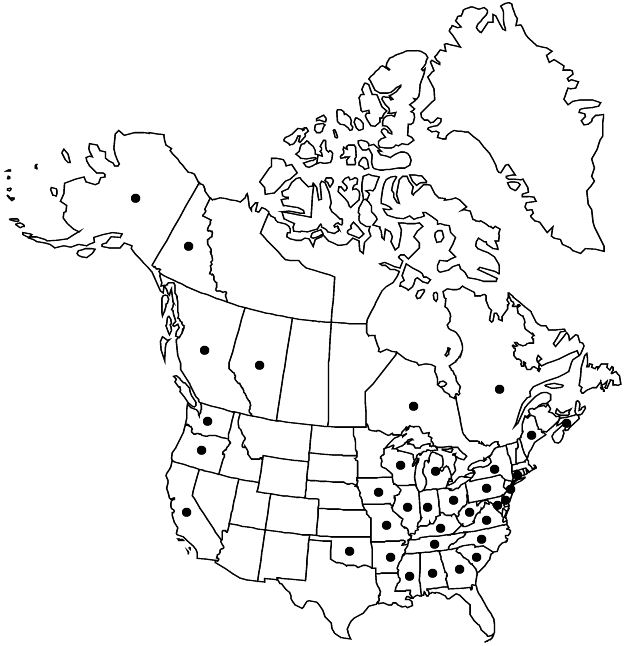Difference between revisions of "Aruncus dioicus"
Rhodora 41: 423. 1939.
FNA>Volume Importer |
RevisionBot (talk | contribs) m (Bot: Adding category Revised Since Print) |
||
| (8 intermediate revisions by 3 users not shown) | |||
| Line 9: | Line 9: | ||
|special_status={{Treatment/ID/Special_status | |special_status={{Treatment/ID/Special_status | ||
|code=F | |code=F | ||
| − | |label= | + | |label=Illustrated |
}} | }} | ||
| − | |basionyms={{Treatment/ID/ | + | |basionyms={{Treatment/ID/Basionym |
|name=Actaea dioica | |name=Actaea dioica | ||
|authority=Walter | |authority=Walter | ||
| + | |rank=species | ||
| + | |publication_title=Fl. Carol., | ||
| + | |publication_place=152. 1788 | ||
}} | }} | ||
|synonyms= | |synonyms= | ||
| Line 26: | Line 29: | ||
-->{{Treatment/Body | -->{{Treatment/Body | ||
| − | |distribution= | + | |distribution=Alta.;B.C.;N.S.;Ont.;Que.;Yukon;Ala.;Alaska;Ark.;Calif.;Conn.;Del.;Ga.;Ill.;Ind.;Iowa;Ky.;Maine;Md.;Mich.;Miss.;Mo.;N.C.;N.J.;N.Y.;Ohio;Okla.;Oreg.;Pa.;S.C.;Tenn.;Va.;W.Va.;Wash.;Wis.;Eurasia. |
|discussion=<p>Varieties 14 (4 in the flora).</p><!-- | |discussion=<p>Varieties 14 (4 in the flora).</p><!-- | ||
| − | --><p>Aruncus dioicus is superficially similar to Astilbe biternata (Saxifragaceae), false goat’s-beard, which is endemic to the southern Appalachian Mountains. Both species produce tall, dioecious plants with biternately to bipinnately compound leaves and plumelike terminal panicles with many, relatively small white, unisexual flowers, and may grow side by side. Aruncus dioicus is more widespread and may be readily distinguished by its unlobed rather than 3-lobed terminal leaflets, flowers with 20 rather than 10 stamens, and 3 carpels reflexed in fruit rather than 2 erect carpels. See T. L. Mellichamp (1976) for an analysis of this remarkable example of convergent evolution.</p><!-- | + | --><p><i>Aruncus dioicus</i> is superficially similar to <i>Astilbe biternata</i> (Saxifragaceae), false goat’s-beard, which is endemic to the southern Appalachian Mountains. Both species produce tall, dioecious plants with biternately to bipinnately compound leaves and plumelike terminal panicles with many, relatively small white, unisexual flowers, and may grow side by side. <i>Aruncus dioicus</i> is more widespread and may be readily distinguished by its unlobed rather than 3-lobed terminal leaflets, flowers with 20 rather than 10 stamens, and 3 carpels reflexed in fruit rather than 2 erect carpels. See T. L. Mellichamp (1976) for an analysis of this remarkable example of convergent evolution.</p><!-- |
| − | --><p>Aruncus dioicus is striking and is grown in gardens throughout North America. It is variable throughout the temperate and subarctic regions of the Northern Hemisphere, especially in China and Japan. H. Hara (1955) recognized the following varieties that are found in the flora area.</p> | + | --><p><i>Aruncus dioicus</i> is striking and is grown in gardens throughout North America. It is variable throughout the temperate and subarctic regions of the Northern Hemisphere, especially in China and Japan. H. Hara (1955) recognized the following varieties that are found in the flora area.</p> |
|tables= | |tables= | ||
|references= | |references= | ||
| Line 68: | Line 71: | ||
-->{{#Taxon: | -->{{#Taxon: | ||
name=Aruncus dioicus | name=Aruncus dioicus | ||
| − | |||
|authority=(Walter) Fernald | |authority=(Walter) Fernald | ||
|rank=species | |rank=species | ||
| Line 75: | Line 77: | ||
|basionyms=Actaea dioica | |basionyms=Actaea dioica | ||
|family=Rosaceae | |family=Rosaceae | ||
| − | |distribution= | + | |distribution=Alta.;B.C.;N.S.;Ont.;Que.;Yukon;Ala.;Alaska;Ark.;Calif.;Conn.;Del.;Ga.;Ill.;Ind.;Iowa;Ky.;Maine;Md.;Mich.;Miss.;Mo.;N.C.;N.J.;N.Y.;Ohio;Okla.;Oreg.;Pa.;S.C.;Tenn.;Va.;W.Va.;Wash.;Wis.;Eurasia. |
|reference=None | |reference=None | ||
|publication title=Rhodora | |publication title=Rhodora | ||
|publication year=1939 | |publication year=1939 | ||
| − | |special status= | + | |special status=Illustrated |
| − | |source xml=https:// | + | |source xml=https://bitbucket.org/aafc-mbb/fna-data-curation/src/2e0870ddd59836b60bcf96646a41e87ea5a5943a/coarse_grained_fna_xml/V9/V9_713.xml |
|subfamily=Rosaceae subfam. Amygdaloideae | |subfamily=Rosaceae subfam. Amygdaloideae | ||
|tribe=Rosaceae tribe Spiraeeae | |tribe=Rosaceae tribe Spiraeeae | ||
| Line 87: | Line 89: | ||
}}<!-- | }}<!-- | ||
| − | -->[[Category:Treatment]][[Category:Aruncus]] | + | --> |
| + | |||
| + | [[Category:Treatment]] | ||
| + | [[Category:Aruncus]] | ||
| + | [[Category:Revised Since Print]] | ||
Latest revision as of 18:08, 6 November 2020
Leaves: leaflets green to gray-green, 6–15 cm, base subcordate to attenuate, apex acute to long-acuminate. Flowers: sepals 1 mm; petals 0.5–1.5 mm, apex acute to obtuse; stamens 1.5–2 mm, filaments slender, ± equal, anthers versatile; styles [0.2–]0.3–0.8 mm. Seeds 1.5–2(–2.5) mm.
Distribution

Alta., B.C., N.S., Ont., Que., Yukon, Ala., Alaska, Ark., Calif., Conn., Del., Ga., Ill., Ind., Iowa, Ky., Maine, Md., Mich., Miss., Mo., N.C., N.J., N.Y., Ohio, Okla., Oreg., Pa., S.C., Tenn., Va., W.Va., Wash., Wis., Eurasia.
Discussion
Varieties 14 (4 in the flora).
Aruncus dioicus is superficially similar to Astilbe biternata (Saxifragaceae), false goat’s-beard, which is endemic to the southern Appalachian Mountains. Both species produce tall, dioecious plants with biternately to bipinnately compound leaves and plumelike terminal panicles with many, relatively small white, unisexual flowers, and may grow side by side. Aruncus dioicus is more widespread and may be readily distinguished by its unlobed rather than 3-lobed terminal leaflets, flowers with 20 rather than 10 stamens, and 3 carpels reflexed in fruit rather than 2 erect carpels. See T. L. Mellichamp (1976) for an analysis of this remarkable example of convergent evolution.
Aruncus dioicus is striking and is grown in gardens throughout North America. It is variable throughout the temperate and subarctic regions of the Northern Hemisphere, especially in China and Japan. H. Hara (1955) recognized the following varieties that are found in the flora area.
Selected References
None.
Lower Taxa
Key
| 1 | Follicles 1.5–2.4 mm; styles 0.3–0.8 mm; seeds 1.5–2 mm | > 2 |
| 1 | Follicles 2.5–5 mm; styles 0.3–0.5 mm; seeds 1.8–2.5 mm | > 3 |
| 2 | Follicles 1.5–2 mm; leaf surfaces glabrous or slightly hairy; s Appalachians and eastward. | Aruncus dioicus var. dioicus |
| 2 | Follicles 1.6–2.4 mm; leaf surfaces densely hairy; w of Appalachians. | Aruncus dioicus var. pubescens |
| 3 | Follicles 2.5–5 mm; Alaska and Yukon to n California. | Aruncus dioicus var. acuminatus |
| 3 | Follicles 2.5–3 mm; introduced, ne United States. | Aruncus dioicus var. vulgaris |